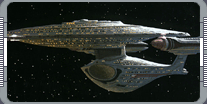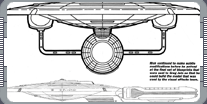
Designing the U.S.S. Enterprise NCC-1701-C - By Andrew Probert.
The third season introduced us to a missing piece of Star Trek history - the Ambassador-class USS Enterprise
NCC-1701-C, a ship that was lost in action 20 years before Picard took control of the USS Enterprise NCC-1701-D.
Looked at one way, the Star Trek: The Next Generation art department started designing the
USS Enterprise NCC-1701-C two years before it was actually needed.
Back in the show's first season, after illustrator Andrew
 Probert had designed the USS Enterprise NCC-1701-D, he got to
thinking about the design linage of Picard's ship. After all, everybody could see that there had to be two
ships between Kirk's Constitution-class
Enterprise-A and Picard's
Galaxy-class vessel.
Probert had designed the USS Enterprise NCC-1701-D, he got to
thinking about the design linage of Picard's ship. After all, everybody could see that there had to be two
ships between Kirk's Constitution-class
Enterprise-A and Picard's
Galaxy-class vessel.
Like most people, Probert assumed the Enterprise-B was an
Excelsior-class ship. (Even at this early stage there was a
relief model of an Excelsior-class Enterprise-B in the observation room.) He reasoned that the 'C' would have
design elements in common with the ships that had come before and after it. "I wanted there to be evidence of
the 'C' growing from the Excelsior and then the 'D' growing from the 'C,'" he remembers. "What I did was I took
a side profile of the Excelsior and I took a side profile of the Galaxy class. Then I put them in the same
scale one above the other and simply drew lines from one to the other at various important points, whether it
was the saucer, the impulse engines, the bridge, the engineering hull, whatever. By doing that I came up with a
composite which became the Enterprise-C." Of course, Probert left the show at the end of the first season, and
in his absence nobody knew exactly what the small color sketch he had produced was meant to be. Rick Sternbach,
who took over all of Probert's duties, says that he thought it was one of the rejected designs for the
Enterprise-D, but the fact that is had design elements in common with the Excelsior lodged in his brain.
Sternbach remembers that his first response to seeing the Enterprise-C mentioned in the breakdown for
'Yesterday's Enterprise' was, 'Oooh, that would be nice.' After this his thought processes were remarkably
 similar to Probert's. "The logical starting point for this design was an intermediate step between the
Excelsior class and Galaxy class. This little color sketch of Andy's from the first season looked like it
would be great to start with; the nacelles were a bit different; I assumed from the sketch that it had more of
a round saucer; it had a very Excelsior-looking neck. It definitely had some interesting design elements."
similar to Probert's. "The logical starting point for this design was an intermediate step between the
Excelsior class and Galaxy class. This little color sketch of Andy's from the first season looked like it
would be great to start with; the nacelles were a bit different; I assumed from the sketch that it had more of
a round saucer; it had a very Excelsior-looking neck. It definitely had some interesting design elements."
Sternbach felt that the sketch wasn't quite detailed enough to show anyone - because it was a three-quarter
view, a lot of things, including the shape of the saucer and how wide the ship was, were open to interpretation,
so he prepared some more drawings that made the shapes absolutely clear. "I took some of the ideas and some
of the design elements of Andy's that were in the sketch, and threw up a top view and a side view in ortho. I
showed those to the producers and made the case that this would an intermediate step and could very well be the
Ambassador-class." At the same time, Sternbach modified the
design to make it a little easier to work with. Probert had always favored compound curves and had given his
ship a very bowed engineering hull that was reminiscent of a sailing ship. Sternbach was concerned that these
complex curves would make the ship difficult to build in the available time, so he made a few modifications.
"I remember making the cross section of the engineering hull circular, simply because it would make fabrication
go faster. By the third season my approach was, 'If we can't build it, then they may write it out!' I think in
that respect I had more of a practical streak than Andy. In this case, an elliptical cross section would have
taken a lot longer to build, and I knew the time pressures that we were all under." The producers aproved the
design and, although everything for 'Yesterday's Enterprise' was designed under intense time pressures,
Sternbach is happy that he had the chance to do all that he needed to. "A major ship always takes a bit longer
than an alien ship of the
 week. I think I gave it about the correct amount of time in terms of ship designing, but it was really up to
[modeler] Greg Jein to get the model produced, and I knew that getting the blueprints out to him as soon as
possible would only be a good thing."
week. I think I gave it about the correct amount of time in terms of ship designing, but it was really up to
[modeler] Greg Jein to get the model produced, and I knew that getting the blueprints out to him as soon as
possible would only be a good thing."
"They were not as fully drawn out as the Enterprise-D simply because there was not a lot of time, but then we
were dealing with Greg, and he knew this stuff. He could be given freehand drawings. I didn't have to draw
everything; I could simply say, 'Take this group of windows or this group of lifeboat hatches and duplicate
them around.' Greg understood the shapes; he understood the details. And what he created was a wonderful
blend of the Galaxy class and the Excelsior class."
|
|
"DESIGNING THE U.S.S. ENTERPRISE NCC-1701-C" - AUGUST 2002 ISSUE 40 STAR TREK: THE MAGAZINE COPYRIGHT OF
PARAMOUNT PICTURES.
|